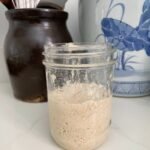
How to Build, Maintain, and Store Your Sourdough Starter
Learn how to create a thriving sourdough starter—a living culture of wild yeast and lactic acid bacteria that naturally leavens artisanal bread and delivers a delicious tangy flavor. This detailed guide will walk you through creating your starter from scratch, maintaining it with regular feedings, troubleshooting common issues, and storing it for daily baking or long-term dormancy.
How to Build, Maintain, and Store Your Sourdough Starter
Equipment
- Container A clear glass or food-grade plastic jar (1 quart) is ideal.Ensure the jar has a loose lid or a cloth cover to allow airflow.
- Scale & Spoon
- A digital kitchen scale ensures accurate measurements.
- Large Spoon Use a non-reactive utensil for stirring.
Ingredients
- Flour Use whole-grain flours such as rye or whole wheat to jump-start fermentation.
- All-purpose flour For ongoing maintenance
- Water Use filtered or dechlorinated water at room temperature, around 75–80 °F, to encourage optimal fermentation.
Instructions
Day 1: The Initial Mix
- Mix Ingredients
- Combine 60 g of whole-grain flour with 60 g of water.
- Stir until the mixture is smooth.
- Resting Period
- Cover the container loosely.
- Let it rest for 24 hours at approximately 75 °F.
Days 2–7: Feeding and Growth
- Twice Daily Feedings
- Discard half of your starter before each feeding.
- Add 60 g of all-purpose flour and 60 g of water.
- Stir thoroughly and cover loosely.
- Watch for Signs of Life
By Days 5–7, your starter should double in size and show abundant bubbles, indicating it’s ready for baking.
- Maintenance & Feeding Ratios
- For a robust sourdough starter, follow these feeding ratios:
- Standard Feed Ratio: 1:1:1 (starter:flour:water by weight) for everyday baking.
- Boosted Feed Ratio: 1:2:2 for accelerating activity in cooler kitchens.
- Float Test: To assess readiness, drop a spoonful of starter in water—it should float when fully aerated.
Notes
- Bubbles But No Rise: Reduce the water content by 10–20% during the next feeding.
- Alcoholic Hooch Formation: Stir hooch back into your starter or pour it off. Increase the frequency of feedings.
- Discoloration or Mold: Discard the affected starter. Clean the jar and utensils thoroughly before starting a new batch.
- Short-Term Storage (Countertop)
- Keep your starter at room temperature.
- Feed it twice daily if baking every day.
- Long-Term Storage (Refrigerator)
- Feed your starter and allow it to peak (approximately 2–4 hours) before refrigerating it in a sealed jar.
- Feed weekly by discarding most of the starter (keeping about 50 g) and refreshing with equal parts flour and water.
- Freezing
- Divide your starter into portions, place in a freezer bag, and freeze for up to 3 months.
- When ready for use, thaw, discard half of the starter, and resume feedings.
- Drying
- Spread the starter thinly on parchment paper and allow it to air-dry completely.
- Store the dried starter in an airtight container.
- Rehydrate with a 1:1 water and flour mix over several days before baking.
Creating and maintaining a sourdough starter is both an art and a science. With patience and the right techniques, you’ll nurture a robust, flavorful culture for artisanal baking. This guide offers clear, user-friendly steps—from building your starter to troubleshooting issues and choosing the best storage strategy—ensuring success in every loaf you bake.
Enjoy your baking journey and watch your sourdough starter come to life!
